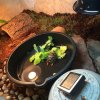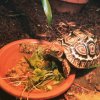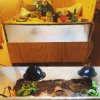haylee345
Member
Hi guys! For a college class, I have to edit a wikipedia page. I of course have chosen to change the leopard tortoise wikipedia page, being the proud tortoise freak I am. Are there any changes you would make to what I've written?
Justification for the Changes (Paragraph needed for class...)
Most owners of leopard tortoises do not know proper husbandry techniques, and countless baby leopard tortoises die every year. Adult leopard tortoises often develop serious pyramiding and metabolic bone disease which leads to a short and painful life. Hopefully, by making this information easily available to new and prospective owners, I will save tortoises’ lives. There is substantial, sometimes vehement debate about many of above mentioned tips, so I tried to provide a moderate perspective. I believe I prevented a fair, sufficient overview of basic husbandry. Providing this information to the public will only be good, although there is little concrete evidence or studies that show the efficacy of my advice. It is largely accumulated from experienced tortoise breeders from a forum where they debate best practice and give advice. I have no ethical qualms.
I will be modifying the “As a Pet” Section of the “Leopard Tortoise” Wikipedia page. The section currently reads:
As a pet[edit]
Leopard tortoises became popular in captivity due to captive breeding. These turtles are very prone to respiratory problems if temperatures are not maintained. Leopard tortoises live at 75-100 degrees Fahrenheit. The southern leopard tortoise is more cold tolerant than the northern leopard tortoise. The leopard tortoise's diet could be supplemented with leafy greens such as mustard greens, collard greens, dandelion, arugula or kale and some fibrous fruits such as apples, pears, pads/fruits of the prickly pear cactus and access to fresh water.
Following are the changes I will make:
Delete: The leopard tortoise's diet could be supplemented with leafy greens such as mustard greens, collard greens, dandelion, arugula or kale and some fibrous fruits such as apples, pears, pads/fruits of the prickly pear cactus and access to fresh water.
Housing a Pet Leopard Tortoise Indoors
Pet leopard tortoises should mostly live indoors for at least the first six months of life while they are small (vulnerable to predators) and delicate. They need a lot of space – at least a 4ftx6ft enclosure. The more roaming room, the better, especially if the tortoise is being housed indoors as an adult. Depending on outdoor temperature and safety, tortoises can begin spending an hour or two outside right away, and after around two years they can be moved outside permanently, although bringing them inside at night might be advisable. They are at risk of predation from birds, raccoons, possums, feral animals, birds, and many other creatures, so they need to be a suitable size before being left outside unsupervised. With these risks in mind, outdoor time is the absolute best thing for a tortoise. Nothing is better than natural sunlight and grazing.
Wet Vs. Dry
Recently, there has been debate over how best to raise a pet leopard tortoise for the first six months-one year of its life. The Old School argument is that leopard tortoises are native to arid grasslands and therefore should be raised “dry” on a sandy substrate with low humidity and no available water. This is said to prevent respiratory infections and lower the risk of young tortoises drowning in water dishes. Recent research of wild leopard tortoises reveal that eggs hatch during a rainy season, with almost marshy conditions for the first few months of a tortoise’s life. Furthermore, tortoises spend a great deal of time under plants and partially or totally hidden in underground burrows where humidity is much higher. This is especially true of young tortoises that are still small enough to be vulnerable to predators.
The New School argues for leopard tortoises to be raised “wet”, especially in the first six months, with at least 80% humidity and frequent soaks. This is shown to help prevent “pyramiding” and metabolic bone disease in leopard tortoises. Crucial to this method is a closed enclosure. Humidity and temperature cannot be maintained in a traditional open-top enclosure. With the wet method, temperatures should never drop below 80°F in order to prevent respiratory infections. The enclosure should include a humid hide such as a terra cotta flower pot slightly buried on its side. The tortoise should be soaked in shallow tepid water (85°F-95°F) at least three times a week for at least fifteen minutes each time. The water should be about a third of the way up the body. Hatchlings should be soaked more often and for longer periods, daily soaks of thirty minutes each being ideal. Shallow water dishes, such as terra cotta plant saucers, should be available to the tortoise 24/7. Water should be too shallow to drown in if the tortoise flips, and the dish should be easy to climb in and out of. Live safe plants and daily misting with a water bottle are useful way to maintain humidity.
Substrate
The enclosure should have 3-6in of substrate to maintain humidity and provide room for shallow burrowing. Options are: Coco coir, fir bark mulch, cypress much, sphagnum moss, or a mixture of the four. Up to 25% of the substrate can be sand, but it comes with the risk of ingestion and impaction.
Lighting and Temperature
A UVA/UVA light is vital for tortoises that do not spend at least two hours outside in the sunlight every week. Coil style bulbs have been proven to harm tortoise’s eyes and should never be used. There should be a basking spot that is 95°F-100°F, and the rest of the habitat should stay at least 75°F (dry) or 80°F (wet). An infrared heat emitter is a good option, preferably one that produces no light.
Diet
A wild leopard tortoise mostly eats a variety of grass and scrub, supplemented by succulents and fallen fruit. They meet their high calcium needs by chewing on bones and eating carnivore feces. In captivity, tortoises should be provided with a large variety of grass, weeds, and grocery store greens, in addition to an unbleached cuttlefish bone (which also helps keep the beak trim). They need greens high in fiber, rich in calcium, high in vitamin A, and with low protein. Growing a mix of grasses and weeds in chemical-free soil is the best option when possible. Grocery store spring mix, collard greens, chard, mustard greens, dandelion greens, endive, escarole, radicchio, bok choy, kale, cactus pads, and other organic dark leafy greens are the best store-bought options. Lettuce, spinach, and succulents may also be fed in moderation as part of a varied diet. Small amounts of squash, zucchini, sweet pepper, and non-citrus fruits can be provided rarely, around once per month. A calcium and mineral supplement can be sprinkled on food weekly.
Sources:
http://www.tortoiseforum.org/threads/how-to-raise-a-healthy-sulcata-or-leopard-version-2-0.78361/
http://www.chelonia.org/articles/pardaliscare.htm
http://www.chelonia.org/articles/mistypardaliscare.htm
http://www.tortoisetrust.org/articles/leopards.htm
I may also include some of the following photos of my own leopard tortoise and enclosure:
Justification for the Changes (Paragraph needed for class...)
Most owners of leopard tortoises do not know proper husbandry techniques, and countless baby leopard tortoises die every year. Adult leopard tortoises often develop serious pyramiding and metabolic bone disease which leads to a short and painful life. Hopefully, by making this information easily available to new and prospective owners, I will save tortoises’ lives. There is substantial, sometimes vehement debate about many of above mentioned tips, so I tried to provide a moderate perspective. I believe I prevented a fair, sufficient overview of basic husbandry. Providing this information to the public will only be good, although there is little concrete evidence or studies that show the efficacy of my advice. It is largely accumulated from experienced tortoise breeders from a forum where they debate best practice and give advice. I have no ethical qualms.
I will be modifying the “As a Pet” Section of the “Leopard Tortoise” Wikipedia page. The section currently reads:
As a pet[edit]
Leopard tortoises became popular in captivity due to captive breeding. These turtles are very prone to respiratory problems if temperatures are not maintained. Leopard tortoises live at 75-100 degrees Fahrenheit. The southern leopard tortoise is more cold tolerant than the northern leopard tortoise. The leopard tortoise's diet could be supplemented with leafy greens such as mustard greens, collard greens, dandelion, arugula or kale and some fibrous fruits such as apples, pears, pads/fruits of the prickly pear cactus and access to fresh water.
Following are the changes I will make:
Delete: The leopard tortoise's diet could be supplemented with leafy greens such as mustard greens, collard greens, dandelion, arugula or kale and some fibrous fruits such as apples, pears, pads/fruits of the prickly pear cactus and access to fresh water.
Housing a Pet Leopard Tortoise Indoors
Pet leopard tortoises should mostly live indoors for at least the first six months of life while they are small (vulnerable to predators) and delicate. They need a lot of space – at least a 4ftx6ft enclosure. The more roaming room, the better, especially if the tortoise is being housed indoors as an adult. Depending on outdoor temperature and safety, tortoises can begin spending an hour or two outside right away, and after around two years they can be moved outside permanently, although bringing them inside at night might be advisable. They are at risk of predation from birds, raccoons, possums, feral animals, birds, and many other creatures, so they need to be a suitable size before being left outside unsupervised. With these risks in mind, outdoor time is the absolute best thing for a tortoise. Nothing is better than natural sunlight and grazing.
Wet Vs. Dry
Recently, there has been debate over how best to raise a pet leopard tortoise for the first six months-one year of its life. The Old School argument is that leopard tortoises are native to arid grasslands and therefore should be raised “dry” on a sandy substrate with low humidity and no available water. This is said to prevent respiratory infections and lower the risk of young tortoises drowning in water dishes. Recent research of wild leopard tortoises reveal that eggs hatch during a rainy season, with almost marshy conditions for the first few months of a tortoise’s life. Furthermore, tortoises spend a great deal of time under plants and partially or totally hidden in underground burrows where humidity is much higher. This is especially true of young tortoises that are still small enough to be vulnerable to predators.
The New School argues for leopard tortoises to be raised “wet”, especially in the first six months, with at least 80% humidity and frequent soaks. This is shown to help prevent “pyramiding” and metabolic bone disease in leopard tortoises. Crucial to this method is a closed enclosure. Humidity and temperature cannot be maintained in a traditional open-top enclosure. With the wet method, temperatures should never drop below 80°F in order to prevent respiratory infections. The enclosure should include a humid hide such as a terra cotta flower pot slightly buried on its side. The tortoise should be soaked in shallow tepid water (85°F-95°F) at least three times a week for at least fifteen minutes each time. The water should be about a third of the way up the body. Hatchlings should be soaked more often and for longer periods, daily soaks of thirty minutes each being ideal. Shallow water dishes, such as terra cotta plant saucers, should be available to the tortoise 24/7. Water should be too shallow to drown in if the tortoise flips, and the dish should be easy to climb in and out of. Live safe plants and daily misting with a water bottle are useful way to maintain humidity.
Substrate
The enclosure should have 3-6in of substrate to maintain humidity and provide room for shallow burrowing. Options are: Coco coir, fir bark mulch, cypress much, sphagnum moss, or a mixture of the four. Up to 25% of the substrate can be sand, but it comes with the risk of ingestion and impaction.
Lighting and Temperature
A UVA/UVA light is vital for tortoises that do not spend at least two hours outside in the sunlight every week. Coil style bulbs have been proven to harm tortoise’s eyes and should never be used. There should be a basking spot that is 95°F-100°F, and the rest of the habitat should stay at least 75°F (dry) or 80°F (wet). An infrared heat emitter is a good option, preferably one that produces no light.
Diet
A wild leopard tortoise mostly eats a variety of grass and scrub, supplemented by succulents and fallen fruit. They meet their high calcium needs by chewing on bones and eating carnivore feces. In captivity, tortoises should be provided with a large variety of grass, weeds, and grocery store greens, in addition to an unbleached cuttlefish bone (which also helps keep the beak trim). They need greens high in fiber, rich in calcium, high in vitamin A, and with low protein. Growing a mix of grasses and weeds in chemical-free soil is the best option when possible. Grocery store spring mix, collard greens, chard, mustard greens, dandelion greens, endive, escarole, radicchio, bok choy, kale, cactus pads, and other organic dark leafy greens are the best store-bought options. Lettuce, spinach, and succulents may also be fed in moderation as part of a varied diet. Small amounts of squash, zucchini, sweet pepper, and non-citrus fruits can be provided rarely, around once per month. A calcium and mineral supplement can be sprinkled on food weekly.
Sources:
http://www.tortoiseforum.org/threads/how-to-raise-a-healthy-sulcata-or-leopard-version-2-0.78361/
http://www.chelonia.org/articles/pardaliscare.htm
http://www.chelonia.org/articles/mistypardaliscare.htm
http://www.tortoisetrust.org/articles/leopards.htm
I may also include some of the following photos of my own leopard tortoise and enclosure:




